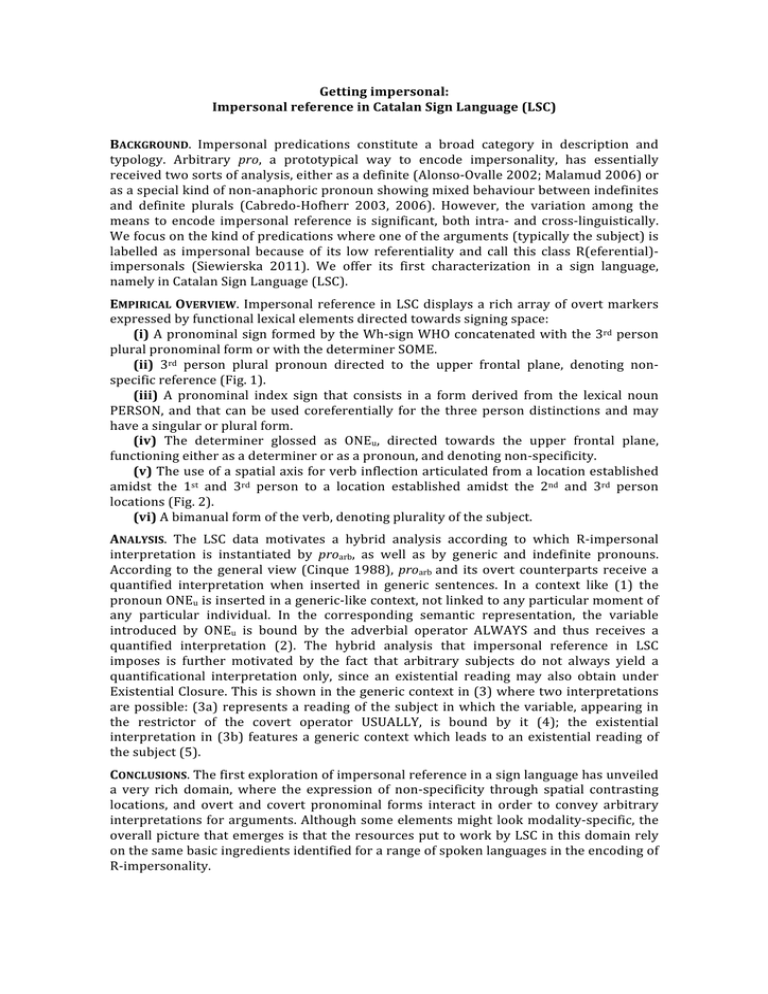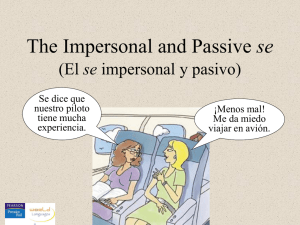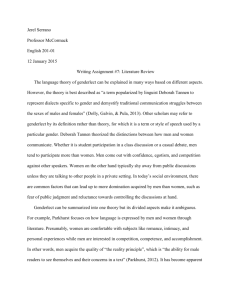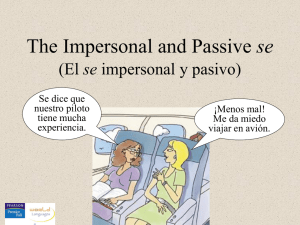Getting impersonal: Impersonal reference in Catalan Sign Language (LSC) B
advertisement

Getting impersonal: Impersonal reference in Catalan Sign Language (LSC) BACKGROUND. Impersonal predications constitute a broad category in description and typology. Arbitrary pro, a prototypical way to encode impersonality, has essentially received two sorts of analysis, either as a definite (Alonso‐Ovalle 2002; Malamud 2006) or as a special kind of non‐anaphoric pronoun showing mixed behaviour between indefinites and definite plurals (Cabredo‐Hofherr 2003, 2006). However, the variation among the means to encode impersonal reference is significant, both intra‐ and cross‐linguistically. We focus on the kind of predications where one of the arguments (typically the subject) is labelled as impersonal because of its low referentiality and call this class R(eferential)‐ impersonals (Siewierska 2011). We offer its first characterization in a sign language, namely in Catalan Sign Language (LSC). EMPIRICAL OVERVIEW. Impersonal reference in LSC displays a rich array of overt markers expressed by functional lexical elements directed towards signing space: (i) A pronominal sign formed by the Wh‐sign WHO concatenated with the 3rd person plural pronominal form or with the determiner SOME. (ii) 3rd person plural pronoun directed to the upper frontal plane, denoting non‐ specific reference (Fig. 1). (iii) A pronominal index sign that consists in a form derived from the lexical noun PERSON, and that can be used coreferentially for the three person distinctions and may have a singular or plural form. (iv) The determiner glossed as ONEu, directed towards the upper frontal plane, functioning either as a determiner or as a pronoun, and denoting non‐specificity. (v) The use of a spatial axis for verb inflection articulated from a location established amidst the 1st and 3rd person to a location established amidst the 2nd and 3rd person locations (Fig. 2). (vi) A bimanual form of the verb, denoting plurality of the subject. ANALYSIS. The LSC data motivates a hybrid analysis according to which R‐impersonal interpretation is instantiated by proarb, as well as by generic and indefinite pronouns. According to the general view (Cinque 1988), proarb and its overt counterparts receive a quantified interpretation when inserted in generic sentences. In a context like (1) the pronoun ONEu is inserted in a generic‐like context, not linked to any particular moment of any particular individual. In the corresponding semantic representation, the variable introduced by ONEu is bound by the adverbial operator ALWAYS and thus receives a quantified interpretation (2). The hybrid analysis that impersonal reference in LSC imposes is further motivated by the fact that arbitrary subjects do not always yield a quantificational interpretation only, since an existential reading may also obtain under Existential Closure. This is shown in the generic context in (3) where two interpretations are possible: (3a) represents a reading of the subject in which the variable, appearing in the restrictor of the covert operator USUALLY, is bound by it (4); the existential interpretation in (3b) features a generic context which leads to an existential reading of the subject (5). CONCLUSIONS. The first exploration of impersonal reference in a sign language has unveiled a very rich domain, where the expression of non‐specificity through spatial contrasting locations, and overt and covert pronominal forms interact in order to convey arbitrary interpretations for arguments. Although some elements might look modality‐specific, the overall picture that emerges is that the resources put to work by LSC in this domain rely on the same basic ingredients identified for a range of spoken languages in the encoding of R‐impersonality. FIGURES AND EXAMPLES Figure 1. Plural pronoun directed towards the upper frontal plane Figure 2. Verb INSULT with agreement in the impersonal axis (1) (2) MOMENT ONEu PERSON HIGH‐SCHOOL FIRST‐TIME, ALWAYS REMEMBER MISS PREVIOUSLY SCHOOL OTHER PAST. ‘When one enters high school, one always misses the good times enjoyed previously at school.’ always [person (x) ∧ enter‐high‐school (x)][previous‐good‐times (y) ∧ miss (x, y)] (3) SEASON SUMMER, IXa CORNER IXa ICE‐CREAM SELLa++ a. ‘In the summertime, they sell ice‐cream at that corner.’ b. ‘In the summertime, there is someone who sells ice‐cream at that corner.’ (4) Usually [afternoon (t) ∧ people (x) ] [sell (x, i)] (5) Usually [afternoon (t)] [people (x) ∧ sell (x, i)] REFERENCES ALONSO‐OVALLE, LUIS. 2002. Arbitrary pronouns are not that indefinite. In Romance Languages and Linguistic Theory 2000: Selected papers from Going Romance 2000, Claire Beyssade, Reineke Bok‐ Bennema, Frank Drijkoningen, and Paola Monachesi (eds.), 253‐270. Amsterdam/Philadelphia: John Benjamins. CABREDO‐HOFHERR, PATRICIA. 2003. Arbitrary readings of third person plural pronominals. In Proceedings of the Conference Sinn und Bedeutung 7. Universität Konstanz, FB Linguistik: Arbeitspapiere des Fachbereichs Sprachwissenschaften Vol 114, Matthias Weisgerber (ed.), 81‐ 94. CABREDO‐HOFHERR, PATRICIA. 2006. ‘Arbitrary’ pro and the theory of pro‐drop. In Arguments and Agreement, Peter Ackema, Patrick Brandt, Maaike Schoorlemmer, and Fred Weerman (eds.), 230– 258. Oxford : Oxford University Press. CINQUE, GUGLIELMO. 1988. On si constructions and the theory of arb. Linguistic Inquiry 19:521–582. MALAMUD, SOPHIA A. 2004. Arbitrariness: a definite account. In WCCFL 23 Proceedings, G. Garding and M. Tsujimura (eds.), 101–114. Somerville, MA: Cascadilla Press. SIEWIERSKA, ANNA. 2011. Overlap and complementarity in reference impersonals: Man‐constructions vs. third person plural‐impersonals in the languages of Europe. In Impersonal Constructions: A cross‐linguistic perspective, Andrej Malchukov, and Anna Siewierska (eds.), 57–90. Amsterdam: John Bejamins.






